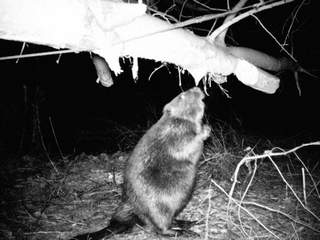Detroit River: First Beaver in 75 Years
Posted by: Loren Coleman on February 16th, 2009
Okay, the media can’t help themselves. Expect more “Leave-It-To-Beaver” headlines and jokes, as this news gets out.
Wildlife officials are celebrating the sighting of an American beaver (Castor canadensis) in the Detroit River for the first time in decades, signaling that efforts to clean up the waterway are paying off.

A photo taken by a Detroit Edison motion-sensitive camera in November 2008, shows a beaver on company property.
The Detroit Free Press announced on February 16, 2009, that a beaver lodge has been discovered in an intake canal at a Detroit Edison riverfront plant. Officials consider the beaver spotted by the utility’s motion-sensitive camera marks the animal’s return to the river for the first time in at least 75 years.
Photos and video were taken in November 2008, but Detroit Edison didn’t want to release them until they could ensure the animal’s safety.
“It’s part of that larger story of ecological recovery,” John Hartig, the Detroit River refuge manager for the U.S. Fish and Wildlife Service, told the paper.
Over the last number of years, other species have returned to the Detroit River area, said Hartig, citing sturgeon, whitefish, peregrine falcons, bald eagles and walleye.
“If it’s cleaner for them, it’s cleaner for us, too,” Hartig said.
See the video here.
About Loren Coleman
Loren Coleman is one of the world’s leading cryptozoologists, some say “the” leading living cryptozoologist. Certainly, he is acknowledged as the current living American researcher and writer who has most popularized cryptozoology in the late 20th and early 21st centuries.
Starting his fieldwork and investigations in 1960, after traveling and trekking extensively in pursuit of cryptozoological mysteries, Coleman began writing to share his experiences in 1969. An honorary member of Ivan T. Sanderson’s Society for the Investigation of the Unexplained in the 1970s, Coleman has been bestowed with similar honorary memberships of the North Idaho College Cryptozoology Club in 1983, and in subsequent years, that of the British Columbia Scientific Cryptozoology Club, CryptoSafari International, and other international organizations. He was also a Life Member and Benefactor of the International Society of Cryptozoology (now-defunct).
Loren Coleman’s daily blog, as a member of the Cryptomundo Team, served as an ongoing avenue of communication for the ever-growing body of cryptozoo news from 2005 through 2013. He returned as an infrequent contributor beginning Halloween week of 2015.
Coleman is the founder in 2003, and current director of the International Cryptozoology Museum in Portland, Maine.










More evidence that if you leave nature alone, it will find a way to take care of itself. As a child in the New Orleans area many years ago, we were all told, “Don’t swim in Lake Pontchartrain, it’s polluted!”. After a number of steps to reduce pollution and the elimination of shell dredging, the brackish lake (actually a large lagoon of the Gulf of Mexico), is now 95-98% pure and in the summer is the new home of a growing number of West Indian manatees. Bottle-nose dolphins and an occasional sea turtle also frequent the lake during the warm months and the Louisiana state bird, the brown pelican (once near extinction in LA due to DDT) has made a strong comeback. As for the rest of us, fishing has never been better. All of this happened after approx. 10 years after conservation measures were taken.
I’m encouraged by these developments. Way to go, Beav!
Well, how about that… A corporation that forgoes immediate publicity in an effort to ensure the protection/survival of an animal. They waited over two months just for the animals’ safety. Applause goes out to Detroit Edison for their efforts!
About 20 years ago, give or take, beavers had come back into north central Iowa. They were building dams in the drainage ditches, and the county blew up the dams and trapped out the beaver.
I’m not surprised they’ve moved on further. I wish that the county hadn’t wiped them out locally, though.
who does not love a good beaver story
How do we know they didn’t import them?
Actually this coincides with the continued exodus from Detroit. The population is literally cut in half from it’s booming 1.8 million mark of the 1950’s. Quite often, when people go away animals come back.
Oh yea, the river thing could have something to do with it too.;)
Beavers aren’t migratory not in the sense that geese are or bison were on the open plains. As habitat fills up, they do spread out looking for suitable territory. I’ve encountered them on land over a mile from the nearest permanent water. Obviously out looking for a new home.
Now that the Detroit River now longer catches on fire, expect more of the critters to show up. They are members of the order rodentia, so they are prolific and will be abundant there within a few years. Trust me. We have tons of beaver and now otters where 15 – 20 years ago there were absolutely none.
With all the otters now, you’d think our cryptid sightings in the water would be off the charts!
Alligator, wrong river.
It was Cleveland, Ohio’s Cuyahoga River that use to catch fire, especially with one well-publicized flaming example.
“Loren Coleman responds: February 17th, 2009 at 9:14 pm
Alligator, wrong river.
It was Cleveland, Ohio’s Cuyahoga River that use to catch fire, especially with one well-publicized flaming example.”
Oops. You are absolutely correct! Boy, do I ever feel sheepish. :0
No reason for an alligator to feel like a sheep when talking about a beaver.
I merely did not want to be responsible for watching a random comment on this blog to wind up in a kid’s biology class report about “the recovery of beavers coming back in a river that use to catch fire,” if you know what I mean.
🙂
Awesome news. Stories about nature making a comeback give me hope for the future of the world’s ecosystems.